T-12 antitank gun
| 2A19 (T-12) 100mm anti-tank gun | |
|---|---|
.jpg) T-12 displayed in the Artillery Museum in Saint Petersburg, Russia. | |
| Type | Anti-tank gun |
| Place of origin | Soviet Union |
| Service history | |
| In service | 1961 – present |
| Used by | See Operators |
| Wars |
Gulf War War of Dagestan War in Donbass |
| Specifications | |
| Weight | 2,750 kg (6,060 lb) |
| Length | 9.16 m (30 ft 1 in)[1] |
| Barrel length | 8.48 m (27 ft 10 in) 63 calibers[1] |
| Width | 1.795 m (5 ft 11 in) |
| Height | 1.565 m (5 ft 2 in) |
| Crew | 6[1] |
|
| |
| Shell | Fixed QF[1] |
| Caliber | 100 millimetres (3.9 in) |
| Carriage |
Transport: Ural-375D (6x6) On road: 60 km/h (37 mph) Off road: 15 km/h (9 mph) |
| Elevation | −10° to +20°[1] |
| Traverse | 27° left or right |
| Rate of fire |
14 rpm (max possible) 10 rpm (max likely) 4 to 6 rpm (typical) |
| Muzzle velocity | See Ammunition |
| Maximum firing range | See Ammunition |
.jpg)
2A19 or T-12 is a Soviet smoothbore 100-mm anti-tank gun, which served as the primary towed anti-tank artillery in the Soviet and Bulgarian armies from the early 1960s to the late 1980s.
History
The T-12 entered service in 1961,[2] replacing the BS-3 100 mm field gun. It was typically deployed in the anti-tank units of armoured and motor rifle regiments to protect flanks against counter-attacks during rapid advances.
In 1970, it was replaced in production by the T-12A or MT-12 "Rapira", which features a new smoothbore gun, the 100 mm 2A29 gun, as well as a redesigned carriage and gun shield to protect the crew from machine gun fire and shell splinters. Thanks to the redesigned carriage, which has a bigger wheel base, the MT-12 can be towed by the MT-LB, at speeds up to 60 km/h on road or 25 km/h cross-country.
The 2A29R "Ruta" or MT-12R is a version with a RLPK-1 radar for engaging targets in a poor visibility environment (smoke/fog). From 1981, the gun could fire laser beam-riding guided missiles 9M117 Kastet (weapon system 9K116) and carried the new designator 2A29K "Kastet" or MT-12K.
The weapon was planned to be superseded by the 2A45 Sprut-B 125 mm smooth bore anti-tank gun. Modern western tanks' frontal armour protection is in excess of what can be penetrated by a 100 mm gun from anything but point-blank range – even using the most modern APFSDS round. For a tank that can manoeuvre to take advantage of the enemy's weaknesses this is less of a problem – but for a weapon that is primarily defensive, this is a serious problem. Today, the T-12 is applied mostly in the role of ordinary artillery, using FRAG-HE shells.
In 2017, the Algerian military displayed a locally developed variant mounted on a Mercedes-Benz Zetros truck. It includes four stabilization legs to absorb firing impacts.[3]
Description
The gun requires a crew of six: commander, driver of the towing vehicle, gun layer, loader, and two ammunition crewmen. When the MT-LB is used as the transporter, 20 rounds are typically carried (10 APFSDS, 4 HE-Frag, 6 HEAT). Since the weapon is a smoothbore, all the ammunition is finned for accuracy during flight.
The standard equipment consists of the panoramic PG-1M sight for indirect fire, and an OP4M-40U telescope for direct fire. The APN-5-40 or APN-6-40 are used for direct fire by night.
The gun can be fitted with the LO-7 ski gear for travel across snow or swampy ground.
Ammunition
Note: penetration numbers for RHA at 90 degrees.
APFSDS
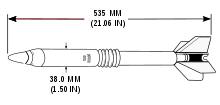
- 3BM-2
APFSDS-T Tungsten
- Round weight: 19.34 kg (42.6 lb)
- Projectile weight: 5.65 kg (12.5 lb)
- Muzzle velocity: 1,575 m/s (5,170 ft/s)
- Maximum range: 3,000 m (3,300 yd)
- Penetration:
- 230 mm at 500 m (9 in at 550 yd)
- 180 mm at 2,000 m (7 in at 2,200 yd)
- 140 mm at 3,000 m (5.5 in at 3,300 yd)
- 3BM23/3UBM10
APFSDS
- Round weight: 19.9 kg (44 lb)
- Projectile weight: 4.55 kg (10.0 lb)
- Muzzle velocity: 1,548 m/s (5,080 ft/s)
- Maximum range: 3,000 m (3,300 yd)
- Penetration: 225 mm at 1000 m (8.8 in at 1100 yd)[4]
HEAT
- 3BK16M/3UBK8
- Round weight: 23.1 kg (51 lb)
- Projectile weight: 9.5 kg (21 lb)
- Muzzle velocity: 975 m/s (3,200 ft/s)
- Maximum range: 1,000 m (1,100 yd)
- Penetration: 400 mm (16 in) [4]
HE-FRAG
- 3OF12/3OF35
- Round weight: 28.9 kg (64 lb)
- Projectile weight: 16.7 kg (37 lb)
- Muzzle velocity: 700 m/s (2,300 ft/s)
- Maximum range (indirect): 8,200 m (9,000 yd)
Guided projectile
- 9K117 Kastet 3UBK10/3UBK10M
Beam riding laser guided projectile.
- Round weight: 24.5 kg (54 lb)
- Projectile weight: 17.6 kg (39 lb)
- Average speed: 300 m/s (980 ft/s)
- Range: 100–5,000 m (110–5,470 yd)
- Penetration: 550–600 mm (22–24 in)
Operators
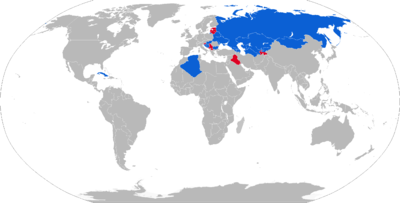







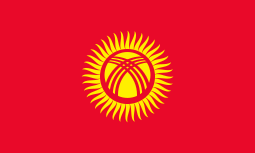


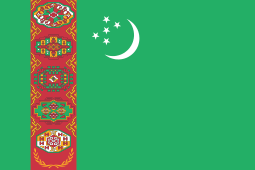


Former operators



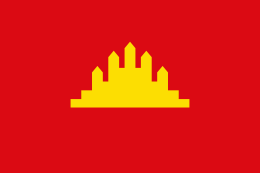




.svg.png)
Variants
Romania
- A407 - This artillery system was designed by Arsenal-Resita and is very similar to the MT-12. It can fire the same range of ammunition as the T-54/55 tank and has a maximum range of 2,200 m (HEAT) or 4,000 m (APC-T). Subversions are the A407M1 and the A407M2. In Romanian Army service, the A407 is known as the 100 mm anti-tank gun M1977 (Romanian: Tun antitanc calibrul 100-mm Model 1977) and is normally towed by the DAC 887R truck.[14] It can also be towed with the DAC 665T truck. The Model 2002 is an improved version, fitted with the automatic fire control system TAT-100.[15]
People's Republic of China
- Type 73 - This appears to be a copy of the Soviet T-12.[16]
- Type 86 - This is a 100mm smoothbore anti-tank gun that has some similarities with the 85mm Type 56 (D-44). It fires ammunition of the fixed type, including the Type 73 HE, Type 73 HEAT, Type 73 APFSDS and Type 86 APFSDS to a maximum range of 1,800 m.[14]
See also
References
- 1 2 3 4 5 Foss, Christopher (1977). Jane's pocket book of towed artillery. New York: Collier. p. 55. ISBN 0020806000. OCLC 911907988.
- ↑ Широкорад А. Б. Гладкоствольные противотанковые пушки («Спрут» и «Рапира») // Техника и вооружение вчера, сегодня, завтра…: Журнал. — Москва: РОО «Техинформ», 1997. — № 10
- ↑ Binnie, Jeremy (4 July 2017). "Algeria displays locally developed self-propelled artillery". IHS Jane's 360. Archived from the original on 6 July 2017. Retrieved 6 July 2017.
- 1 2 http://fas.org/man/dod-101/sys/land/row/t-12.htm
- ↑ Nerguizian, Aram; Cordesman, Anthony (2009). The North African Military Balance: Force Developments in the Maghreb. Washington DC: Center for Strategic and International Studies Press. pp. 44–46. ISBN 978-089206-552-3.
- 1 2 3 4 5 6 7 8 9 10 11 "Trade Registers". Armstrade.sipri.org. Retrieved 2013-06-20.
- 1 2 3 4 5 6 7 "Future Artillery Systems: 2016 Market Report" (PDF). Tidworth: Defence IQ. 2016. Archived from the original (PDF) on 22 January 2018. Retrieved 21 January 2017.
- ↑ "Bosnia Herzegovina Land Forces military equipment, armament and vehicles Army". Armyrecognition.com. Retrieved 2014-10-15.
- ↑ Gribincea, Mihai (2001). The Russian policy on military bases: Georgia and Moldova. Oradea: Editura Cogito. p. 223. ISBN 978-9738032200.
- ↑ "United Nations Register of Conventional Arms: Report of the Secretary-General" (PDF). New York: United Nations. 14 July 2009. Archived from the original (PDF) on 20 June 2017. Retrieved 20 June 2017.
- ↑ Zaloga, Stephen (2015). T-64 Battle Tank: The Cold War’s Most Secret Tank. Oxford: Osprey Publishing. p. 44. ISBN 978-1472806284.
- ↑
- ↑ "Lectures and General Exercises of the General Staff Academy of the Armed Forces of the USSR" (PDF). Langley: Central Intelligence Agency. 28 August 1977. Archived from the original (PDF) on 22 January 2017. Retrieved 20 May 2017.
- 1 2 Janes Armour and Artillery 2003-2004
- ↑ http://www.arsenal.ro/Arsenal/%5Bpermanent+dead+link%5D
- ↑ Jane's Armour and Artillery 2003-2004
- Hull, A.W., Markov, D.R., Zaloga, S.J. (1999). Soviet/Russian Armor and Artillery Design Practices 1945 to Present. Darlington Productions. ISBN 1-892848-01-5.
- Foss, F., Christopher, Artillery of the World
- USA Today article - https://www.usatoday.com/news/world/iraq/2003-03-25-war-zone_x.htm
- 100 mm Ammunition https://web.archive.org/web/20070927080509/http://www.milparade.com/catalog/pdf/698.pdf
- 100 mm Ammunition https://web.archive.org/web/20070927080621/http://www.milparade.com/catalog/pdf/697.pdf
- 100 mm Ammunition https://web.archive.org/web/20041223234049/http://www.milparade.com/catalog/pdf/696.pdf
- MT-12 https://web.archive.org/web/20041214105425/http://www.milparade.com/catalog/pdf/99.pdf
- Jane's Armour and Artillery 2005-2006
- http://rbase.new-factoria.ru/missile/wobb/bastion/bastion.shtml
External links
| Wikimedia Commons has media related to 100 mm anti-tank gun T-12. |
- T-12 walkaround on DishModels.ru
- http://www.globalsecurity.org/military/world/russia/t-12.htm
- Profile part of The Wirlwind War a publication of the United States Army Center of Military History
- https://web.archive.org/web/20041223150348/http://www.milparade.com/catalog/part5/tank_rounds.shtml
- http://www.arsenal.ro/Arsenal/%5Bpermanent+dead+link%5D